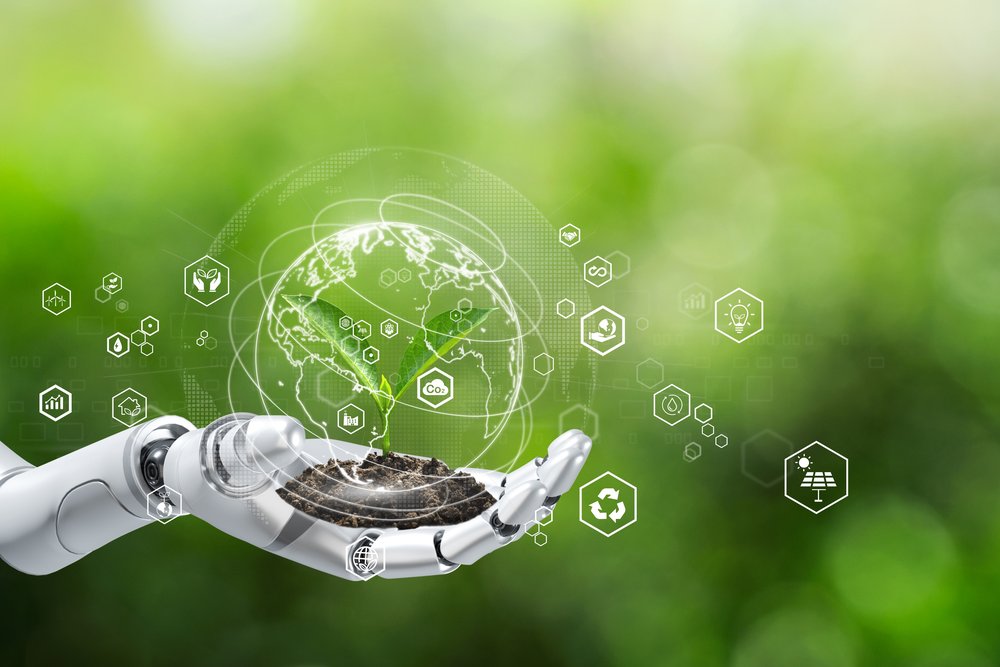Climate change is a global crisis that needs to be addressed immediately. The globe is currently about 1.2°C warmer than it was in pre-industrial times, and the long-term impact of gases that have already been released is compounded by the difficulty of halting emissions overnight.
However, rapid advancements in artificial intelligence (AI), green information and communication technologies (ICTs), and robotics offer some hope in our fight against climate change. In this context, green AI is a promising solution that can help us detect, adapt, and respond to climate change in many areas, such as weather forecasting, transportation, agriculture, and energy efficiency, or by reducing emissions from transportation, agriculture, and industry.
Green AI is a subset of artificial intelligence that strives for sustainability through environmentally sustainable AI models with lower computational costs and fewer carbon emissions. It entails designing and developing algorithms, models, and systems that are environmentally friendly and sustainable. Unlike conventional AI, renewable artificial intelligence is intended to minimize its environmental impact and promote sustainable practices.
The Applications of Green AI in Combating Climate Change
- Reduction of Emissions From Transportation
- Optimization of Energy Efficiency
- Agricultural Improvement
- Forest Protection
- Renewable Energy Sources Development
- Protection of Natural Resources
- Prediction and Response to the Impacts of Climate Change
Reduction of Emissions From Transportation
Green AI has the potential to significantly reduce emissions from transportation by optimizing traffic flow, reducing congestion, and improving fuel efficiency. For instance, Google’s “Project Green Light” uses artificial intelligence to optimize traffic signals and reduce stops. This has resulted in up to 30% fewer stops and an average 10% decrease in estimated CO2 and pollution. Moreover, artificial intelligence tools can also improve fuel efficiency by analyzing driver behavior, performing predictive maintenance, and even optimizing routes.
Optimization of Energy Efficiency
Sustainable artificial intelligence also fights climate change by optimizing energy efficiency in buildings, factories, and other facilities. It reduces energy consumption and waste by analyzing data from sensors, smart meters, and other sources to identify patterns and anomalies in energy usage. It then provides recommendations for reducing energy consumption and unnecessary waste.
As an example, consider how it can improve heating, ventilation, and air conditioning (HVAC) systems by modifying airflow and temperature in response to occupancy, meteorological conditions, and other variables. These intelligent machines can also help optimize lighting systems by adjusting brightness and color temperature based on occupancy, time of day, and other factors.
Agricultural Improvement
Artificial intelligence (AI) is a promising technology that can also assist us in combating climate change by improving agricultural practices. One way AI helps farmers transition from the Green Revolution to a more sustainable future is through precision farming. AI-powered precision farming can help farmers monitor crop moisture, soil composition, and temperature in growing areas.
This enables them to increase yields by learning how to care for their crops and determine the optimal amount of water or fertilizer to use, reducing waste, increasing farm productivity, and increasing farmers’ incomes while improving supply chain efficiency, transparency, and sustainable resource use.
Forest Protection
Another way green artificial intelligence can be used to fight against climate change is by protecting forests. Forests are essential for the health of the planet because they store carbon, regulate water cycles, and provide habitat for biodiversity. However, deforestation and degradation threaten forests around the world, contributing to greenhouse gas emissions and biodiversity loss.
AI is capable of protecting forests by using satellite imagery, sensors, and machine learning to monitor forest conditions, detect illegal activities, and predict future deforestation risks. A popular example is PrevisIA, an AI platform that analyzes complex data to forecast where deforestation will happen next in the Brazilian Amazon. This information can help conservationists and authorities prevent forest loss and restore damaged areas.
In addition, green artificial intelligence technology also helps optimize forest management and restoration by providing accurate inventories of forest resources, identifying suitable sites for planting trees, and assessing the impacts of different interventions.
Renewable Energy Sources Development
The design and functioning of renewable energy systems, like solar panels and wind turbines, are also being improved with the help of green artificial intelligence. Green AI can predict energy generation based on weather patterns by analyzing large amounts of data. This allows for efficient energy storage and distribution and reduces our reliance on fossil fuels, which helps to mitigate climate change. Furthermore, using meteorological and geographic data, this type of AI can locate possible locations for new renewable energy installations. This technology advances the development of renewable energy sources and moves us closer to a more sustainable future.
Protection of Natural Resources
Climate-smart artificial intelligence is also critical for the preservation of natural resources, as it has the capability to analyze large amounts of environmental data to monitor and forecast the impact of human activities on natural resources. For example, it can track deforestation rates, water usage, soil degradation, and other information that can be used to guide policy-making and resource management strategies, ensuring the sustainable use of natural resources. In addition, green AI is helpful in designing more efficient systems for resource extraction and use, reducing waste, and minimizing human environmental impact.
Prediction and Response to the Impacts of Climate Change
One of the most beneficial features of any artificial intelligence tool is its ability to predict and automatically respond to issues. Green artificial intelligence is no exception, as it is critical for predicting and responding to the effects of climate change. It can analyze complex climate models and large data sets to forecast climate trends and extreme weather events. This predictive capability allows for proactive measures, which can help reduce the damage caused by climate change. Besides, it is useful in designing adaptive strategies, such as optimized evacuation routes during disasters or efficient distribution of resources in affected areas.
Conclusion
Green AI has a lot of potential to help us fight climate change. From optimizing renewable energy to protecting natural resources and predicting climate impacts, it’s a game-changer. However, in order to realize this potential, we need to raise awareness of environmentally friendly artificial intelligence (AI) practices and adopt them widely. Let’s embrace sustainable AI solutions and create a sustainable future for all.










